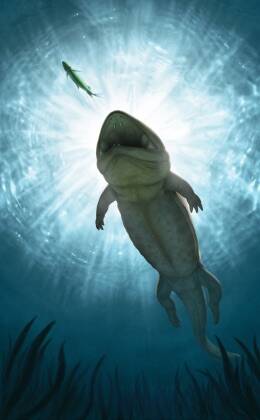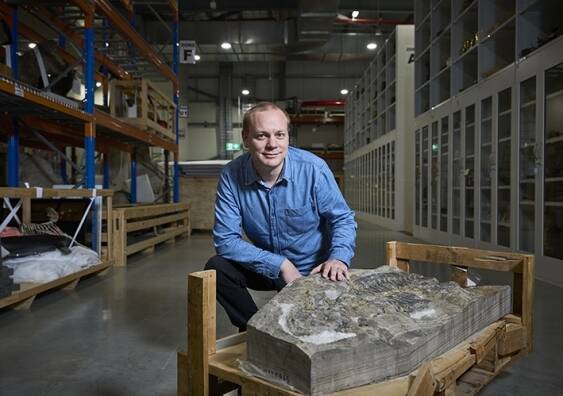The fossil of Arenaerpeton supinatus was first found by a retired chicken farmer in the late '90s.

UNSW Sydney/Richard FreemanThe immaculately preserved fossil of Arenaerpeton supinatus.
Decades ago, a retired chicken farmer in New South Wales unearthed the fossilized remains of an ancient creature. It was a remarkable specimen: immaculately preserved, with its head and body still attached.
Now, researchers have identified the 240-million-year-old giant salamander-like creature — a discovery that some experts say could “rewrite the evolution of amphibians in Australia.”
As the BBC reported, Mihail Mihaildi first discovered the ancient amphibian fossil while fixing the broken garden wall of his home in Umina, a town roughly 90 minutes north of Sydney.
Mihaildi had purchased a roughly 3,200-pound slab of sandstone intending to fix the wall, but once he began to slice through the stone’s outer layers, he noticed something embedded within.
Realizing he had come across something significant, Mihaildi contacted the Australian Museum in Sydney. In 1997, he gave them the fossil.
There, at the Australian Museum in Sydney, the fossil was put on display in a climate-controlled room. And that’s where Lachlan Hart — the paleontologist who ultimately identified the remains — first saw it.
“I was obsessed with dinosaurs… and so 12-year-old me saw that fossil on display back in 1997. And then 25 years later it became part of my PhD, which is insane,” he told the BBC.
Hart eventually became part of a team studying Australia’s Triassic era — roughly 250 million years ago — and said it was “dumb luck” that his team was given the fossil to identify.

UNSWAn artist’s interpretation of Arenaerpeton.
“We don’t often find skeletons with the head and body still attached, and the soft tissue preservation is an even rarer occurrence,” Hart said in university release about the team’s findings that were recently published in the Journal of Vertebrate Paleontology.
Based on the team’s analysis, Hart and colleagues determined that the ancient amphibian was around four feet long and had a body shape similar to a salamander. They gave it the name Arenaepeton supinatus, meaning “sand creeper on its back” in Latin.
“Superficially, Arenaerpeton looks a lot like the modern Chinese Giant Salamander, especially in the shape of its head,” Hart said. “However, from the size of the ribs and the soft tissue outline preserved on the fossil we can see that it was considerably more heavyset than its living descendants.”
Hart also noted that Arenaerpeton also had “some pretty gnarly teeth, including a pair of fang-like tusks on the roof of its mouth.”
Researchers said that during its time, Arenaerpeton lived in Australia’s freshwater rivers.
“This fossil is a unique example of a group of extinct animals known as temnospondyls, which lived before and during the time of the dinosaurs,” Hart said.
Temnospondyls were resilient creatures, surviving two of Earth’s five mass-extinction events, including one 66 million years ago in which a series of volcanic eruptions killed off between 70 and 80 percent of all dinosaurs.

UNSW Sydney/Richard FreemanPaleontologist Lachlan Hart with the fossil of Arenaerpeton.
“The last of the temnospondyls were in Australia 120 million years after Arenaerpeton, and some grew to massive sizes,” Hart said. “The fossil record of temnospondyls spans across two mass extinction events, so perhaps this evolution of increased size aided in their longevity.”
Matthew McCurry, a senior lecturer at the University of South New Wales’ School of BEES and Curator of Paleontology at the Australian Museum, described the find as “one of the most important fossils found in New South Wales in the past 30 years… It represents a key part of Australia’s fossil heritage.”
After learning about this new find in Australia, read about the discovery of a pair of flies fossilized in amber mid-coitus that was also found in Australia. Then, read about the 300-million-year-old blob fossil that scientists never realized was a jellyfish.





